Diabetes (Obesity)
VerifiedAdded on 2023/04/07
|11
|1526
|380
AI Summary
This assignment discusses the incidence and prevalence of diabetes, morbidity and mortality rates, and health promotion strategies to address these issues.
Contribute Materials
Your contribution can guide someone’s learning journey. Share your
documents today.

Running head: DIABETES (OBESITY)
Name of the student;
Name of the university:
Author’s note:
Name of the student;
Name of the university:
Author’s note:
Secure Best Marks with AI Grader
Need help grading? Try our AI Grader for instant feedback on your assignments.
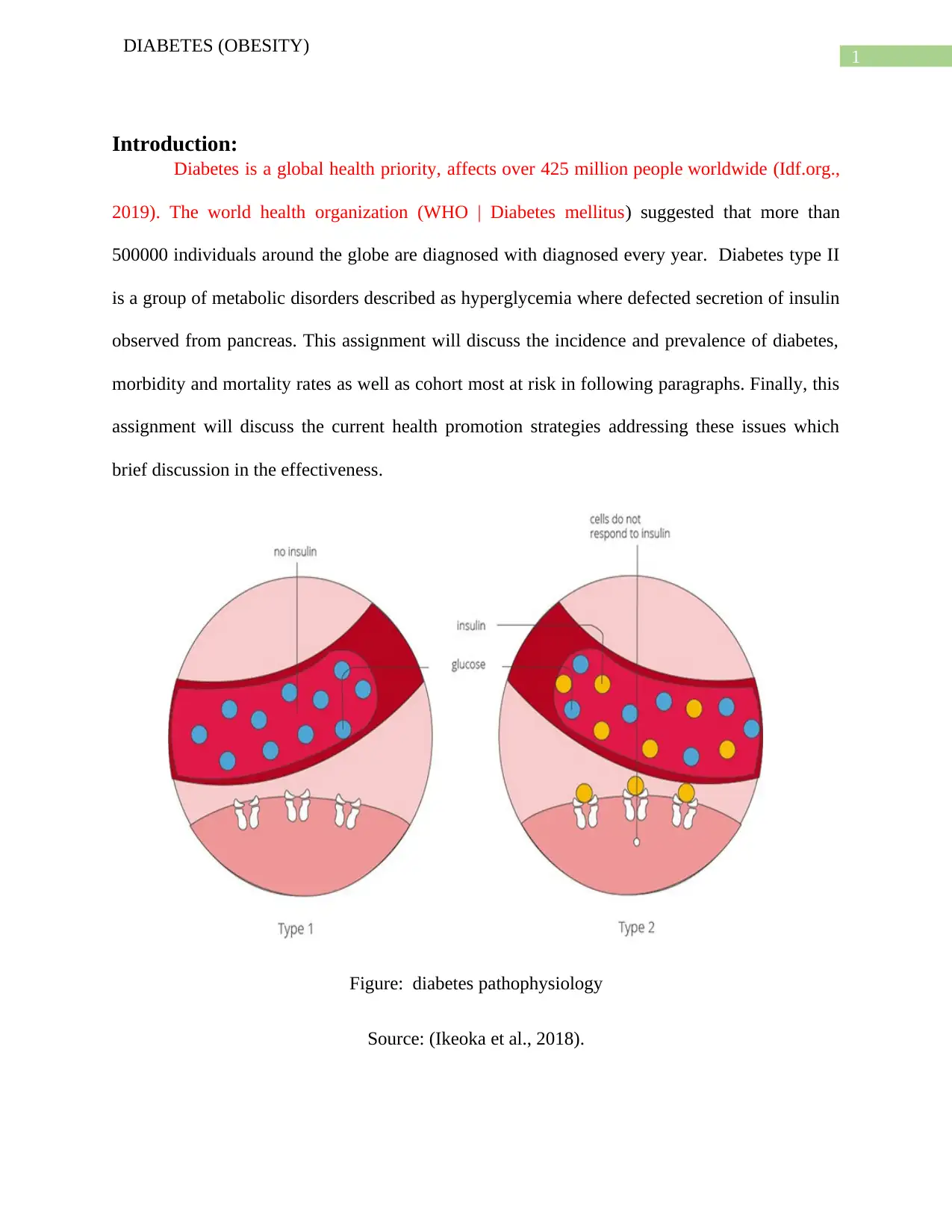
1
DIABETES (OBESITY)
Introduction:
Diabetes is a global health priority, affects over 425 million people worldwide (Idf.org.,
2019). The world health organization (WHO | Diabetes mellitus) suggested that more than
500000 individuals around the globe are diagnosed with diagnosed every year. Diabetes type II
is a group of metabolic disorders described as hyperglycemia where defected secretion of insulin
observed from pancreas. This assignment will discuss the incidence and prevalence of diabetes,
morbidity and mortality rates as well as cohort most at risk in following paragraphs. Finally, this
assignment will discuss the current health promotion strategies addressing these issues which
brief discussion in the effectiveness.
Figure: diabetes pathophysiology
Source: (Ikeoka et al., 2018).
DIABETES (OBESITY)
Introduction:
Diabetes is a global health priority, affects over 425 million people worldwide (Idf.org.,
2019). The world health organization (WHO | Diabetes mellitus) suggested that more than
500000 individuals around the globe are diagnosed with diagnosed every year. Diabetes type II
is a group of metabolic disorders described as hyperglycemia where defected secretion of insulin
observed from pancreas. This assignment will discuss the incidence and prevalence of diabetes,
morbidity and mortality rates as well as cohort most at risk in following paragraphs. Finally, this
assignment will discuss the current health promotion strategies addressing these issues which
brief discussion in the effectiveness.
Figure: diabetes pathophysiology
Source: (Ikeoka et al., 2018).
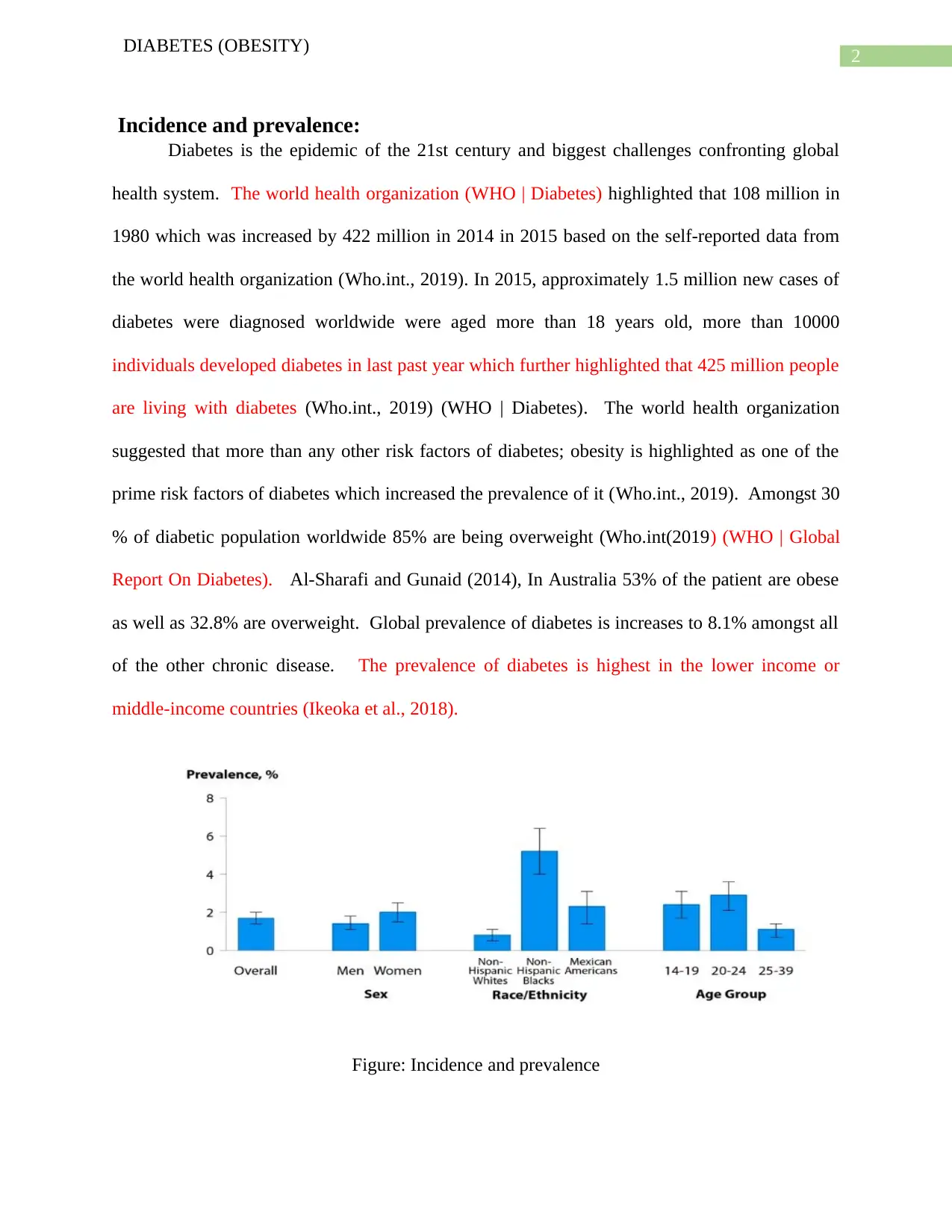
2
DIABETES (OBESITY)
Incidence and prevalence:
Diabetes is the epidemic of the 21st century and biggest challenges confronting global
health system. The world health organization (WHO | Diabetes) highlighted that 108 million in
1980 which was increased by 422 million in 2014 in 2015 based on the self-reported data from
the world health organization (Who.int., 2019). In 2015, approximately 1.5 million new cases of
diabetes were diagnosed worldwide were aged more than 18 years old, more than 10000
individuals developed diabetes in last past year which further highlighted that 425 million people
are living with diabetes (Who.int., 2019) (WHO | Diabetes). The world health organization
suggested that more than any other risk factors of diabetes; obesity is highlighted as one of the
prime risk factors of diabetes which increased the prevalence of it (Who.int., 2019). Amongst 30
% of diabetic population worldwide 85% are being overweight (Who.int(2019) (WHO | Global
Report On Diabetes). Al-Sharafi and Gunaid (2014), In Australia 53% of the patient are obese
as well as 32.8% are overweight. Global prevalence of diabetes is increases to 8.1% amongst all
of the other chronic disease. The prevalence of diabetes is highest in the lower income or
middle-income countries (Ikeoka et al., 2018).
Figure: Incidence and prevalence
DIABETES (OBESITY)
Incidence and prevalence:
Diabetes is the epidemic of the 21st century and biggest challenges confronting global
health system. The world health organization (WHO | Diabetes) highlighted that 108 million in
1980 which was increased by 422 million in 2014 in 2015 based on the self-reported data from
the world health organization (Who.int., 2019). In 2015, approximately 1.5 million new cases of
diabetes were diagnosed worldwide were aged more than 18 years old, more than 10000
individuals developed diabetes in last past year which further highlighted that 425 million people
are living with diabetes (Who.int., 2019) (WHO | Diabetes). The world health organization
suggested that more than any other risk factors of diabetes; obesity is highlighted as one of the
prime risk factors of diabetes which increased the prevalence of it (Who.int., 2019). Amongst 30
% of diabetic population worldwide 85% are being overweight (Who.int(2019) (WHO | Global
Report On Diabetes). Al-Sharafi and Gunaid (2014), In Australia 53% of the patient are obese
as well as 32.8% are overweight. Global prevalence of diabetes is increases to 8.1% amongst all
of the other chronic disease. The prevalence of diabetes is highest in the lower income or
middle-income countries (Ikeoka et al., 2018).
Figure: Incidence and prevalence
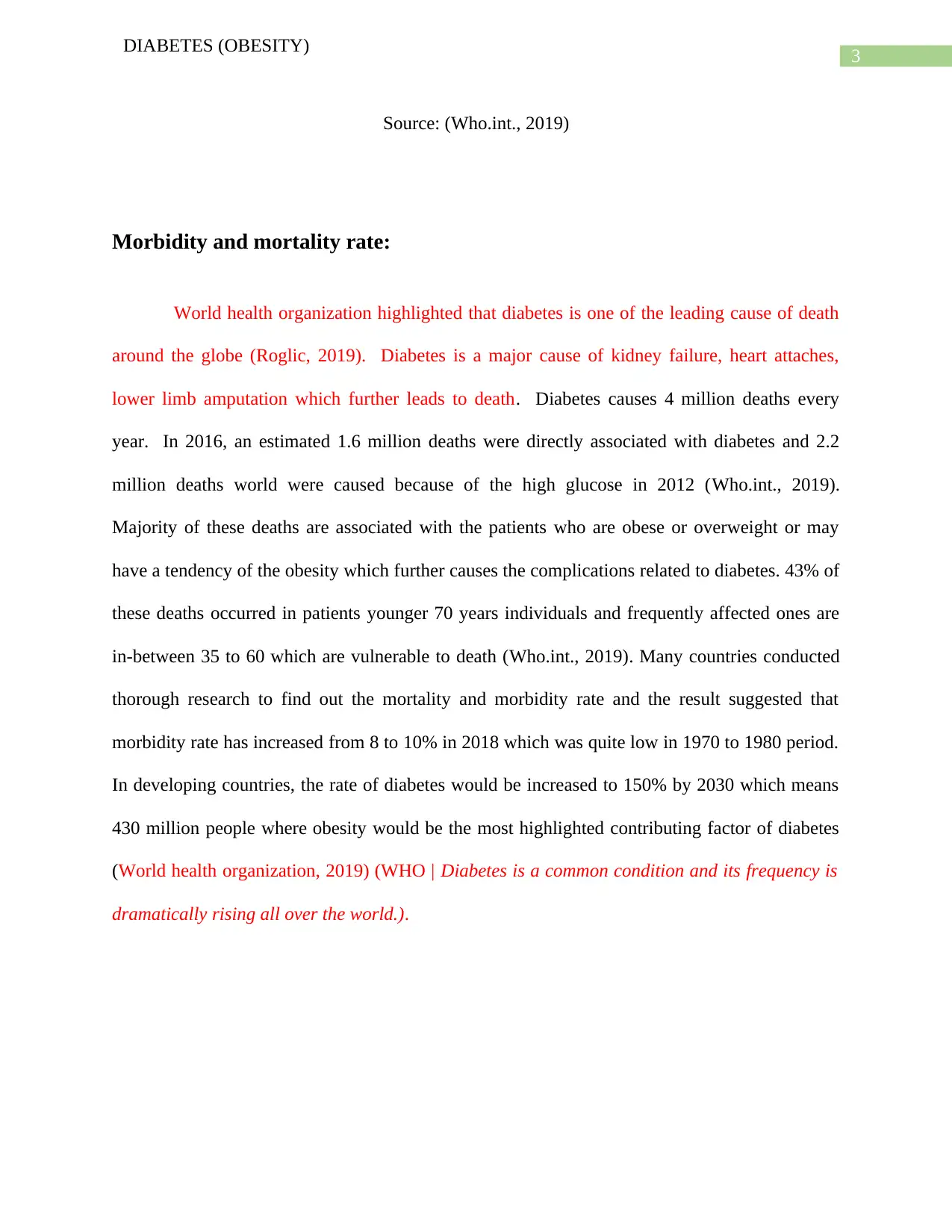
3
DIABETES (OBESITY)
Source: (Who.int., 2019)
Morbidity and mortality rate:
World health organization highlighted that diabetes is one of the leading cause of death
around the globe (Roglic, 2019). Diabetes is a major cause of kidney failure, heart attaches,
lower limb amputation which further leads to death. Diabetes causes 4 million deaths every
year. In 2016, an estimated 1.6 million deaths were directly associated with diabetes and 2.2
million deaths world were caused because of the high glucose in 2012 (Who.int., 2019).
Majority of these deaths are associated with the patients who are obese or overweight or may
have a tendency of the obesity which further causes the complications related to diabetes. 43% of
these deaths occurred in patients younger 70 years individuals and frequently affected ones are
in-between 35 to 60 which are vulnerable to death (Who.int., 2019). Many countries conducted
thorough research to find out the mortality and morbidity rate and the result suggested that
morbidity rate has increased from 8 to 10% in 2018 which was quite low in 1970 to 1980 period.
In developing countries, the rate of diabetes would be increased to 150% by 2030 which means
430 million people where obesity would be the most highlighted contributing factor of diabetes
(World health organization, 2019) (WHO | Diabetes is a common condition and its frequency is
dramatically rising all over the world.).
DIABETES (OBESITY)
Source: (Who.int., 2019)
Morbidity and mortality rate:
World health organization highlighted that diabetes is one of the leading cause of death
around the globe (Roglic, 2019). Diabetes is a major cause of kidney failure, heart attaches,
lower limb amputation which further leads to death. Diabetes causes 4 million deaths every
year. In 2016, an estimated 1.6 million deaths were directly associated with diabetes and 2.2
million deaths world were caused because of the high glucose in 2012 (Who.int., 2019).
Majority of these deaths are associated with the patients who are obese or overweight or may
have a tendency of the obesity which further causes the complications related to diabetes. 43% of
these deaths occurred in patients younger 70 years individuals and frequently affected ones are
in-between 35 to 60 which are vulnerable to death (Who.int., 2019). Many countries conducted
thorough research to find out the mortality and morbidity rate and the result suggested that
morbidity rate has increased from 8 to 10% in 2018 which was quite low in 1970 to 1980 period.
In developing countries, the rate of diabetes would be increased to 150% by 2030 which means
430 million people where obesity would be the most highlighted contributing factor of diabetes
(World health organization, 2019) (WHO | Diabetes is a common condition and its frequency is
dramatically rising all over the world.).
Secure Best Marks with AI Grader
Need help grading? Try our AI Grader for instant feedback on your assignments.

4
DIABETES (OBESITY)
Figure: Mortality and morbidity complications.
Source: (Who.int., 2019)
The cohort at risk of diabetes:
Considering the vulnerable countries, China, India and the United States are the top three
countries where populations are most vulnerable to diabetes and have experienced a higher rate
of mortality and morbidity (Endocrine.org., 2019). Kharroubi and Darwish, H. M. (2015),
highlighted that the sedentary lifestyle, pre-diabetic, smoking, and alcohol consumption,
overweight or obese, individuals with a family history were highlighted as the risk factors of
diabetes. 75% of prevalent cases live in low and middle-income countries where obesity is
highlighted as the most frequent risk factor of developing diabetes around the globe (Domingueti
DIABETES (OBESITY)
Figure: Mortality and morbidity complications.
Source: (Who.int., 2019)
The cohort at risk of diabetes:
Considering the vulnerable countries, China, India and the United States are the top three
countries where populations are most vulnerable to diabetes and have experienced a higher rate
of mortality and morbidity (Endocrine.org., 2019). Kharroubi and Darwish, H. M. (2015),
highlighted that the sedentary lifestyle, pre-diabetic, smoking, and alcohol consumption,
overweight or obese, individuals with a family history were highlighted as the risk factors of
diabetes. 75% of prevalent cases live in low and middle-income countries where obesity is
highlighted as the most frequent risk factor of developing diabetes around the globe (Domingueti
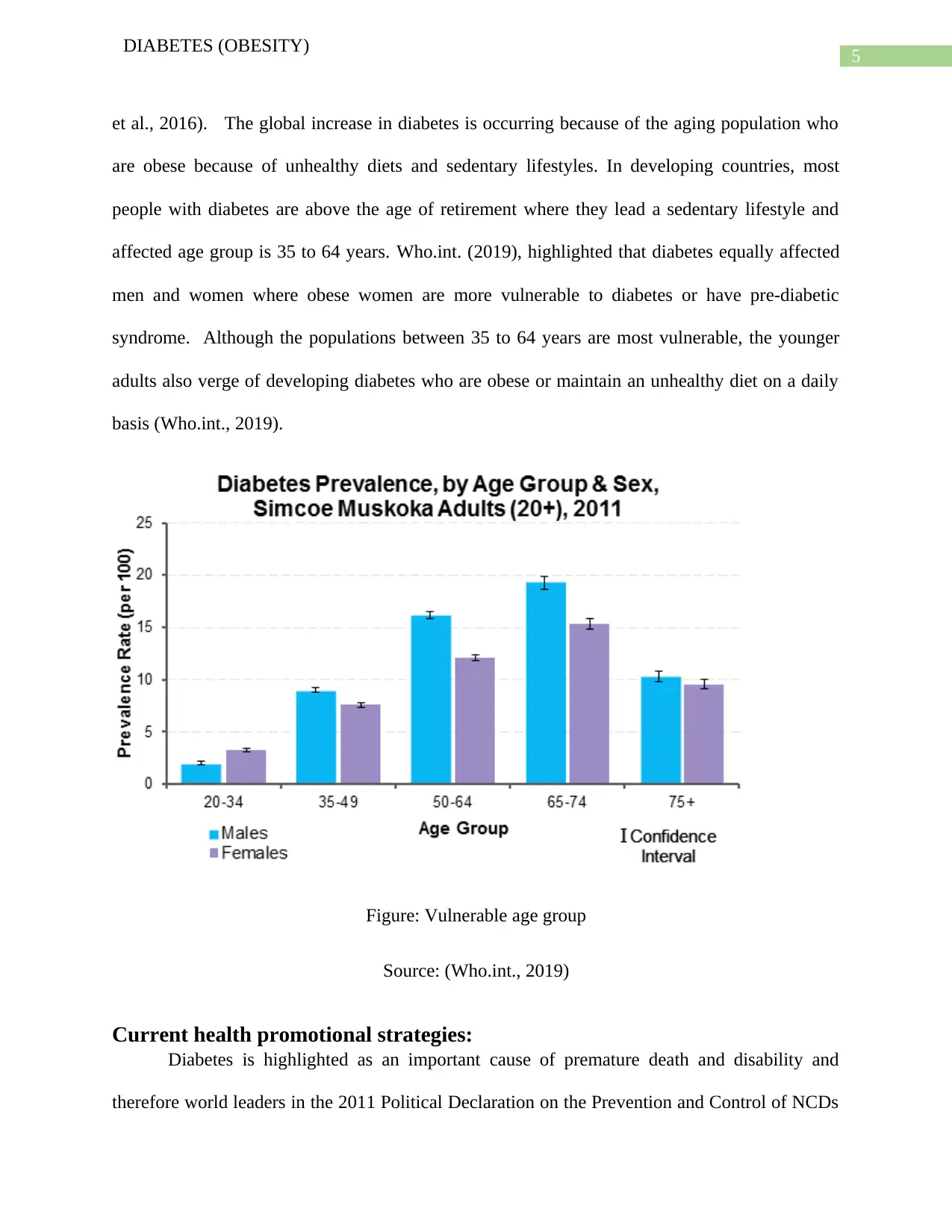
5
DIABETES (OBESITY)
et al., 2016). The global increase in diabetes is occurring because of the aging population who
are obese because of unhealthy diets and sedentary lifestyles. In developing countries, most
people with diabetes are above the age of retirement where they lead a sedentary lifestyle and
affected age group is 35 to 64 years. Who.int. (2019), highlighted that diabetes equally affected
men and women where obese women are more vulnerable to diabetes or have pre-diabetic
syndrome. Although the populations between 35 to 64 years are most vulnerable, the younger
adults also verge of developing diabetes who are obese or maintain an unhealthy diet on a daily
basis (Who.int., 2019).
Figure: Vulnerable age group
Source: (Who.int., 2019)
Current health promotional strategies:
Diabetes is highlighted as an important cause of premature death and disability and
therefore world leaders in the 2011 Political Declaration on the Prevention and Control of NCDs
DIABETES (OBESITY)
et al., 2016). The global increase in diabetes is occurring because of the aging population who
are obese because of unhealthy diets and sedentary lifestyles. In developing countries, most
people with diabetes are above the age of retirement where they lead a sedentary lifestyle and
affected age group is 35 to 64 years. Who.int. (2019), highlighted that diabetes equally affected
men and women where obese women are more vulnerable to diabetes or have pre-diabetic
syndrome. Although the populations between 35 to 64 years are most vulnerable, the younger
adults also verge of developing diabetes who are obese or maintain an unhealthy diet on a daily
basis (Who.int., 2019).
Figure: Vulnerable age group
Source: (Who.int., 2019)
Current health promotional strategies:
Diabetes is highlighted as an important cause of premature death and disability and
therefore world leaders in the 2011 Political Declaration on the Prevention and Control of NCDs
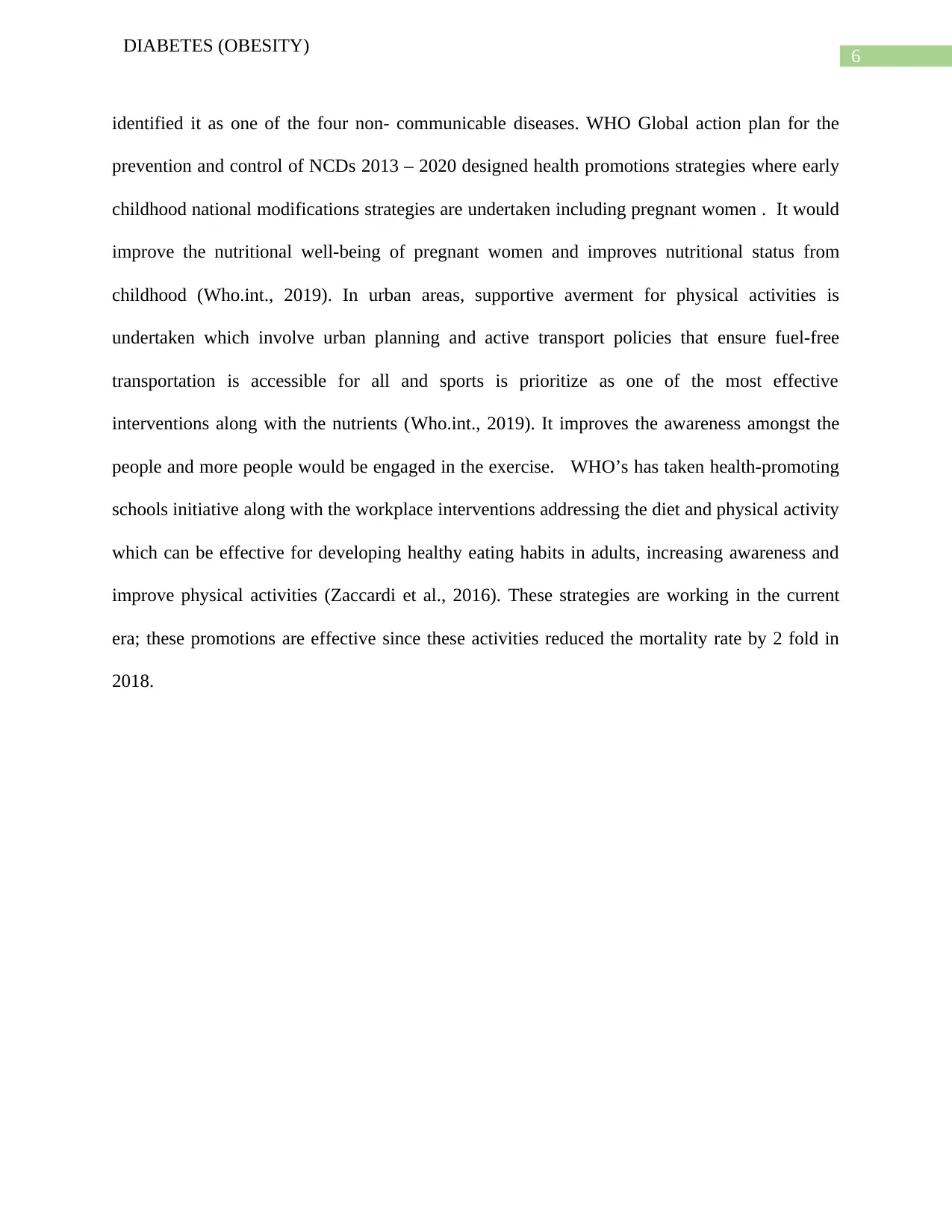
6
DIABETES (OBESITY)
identified it as one of the four non- communicable diseases. WHO Global action plan for the
prevention and control of NCDs 2013 – 2020 designed health promotions strategies where early
childhood national modifications strategies are undertaken including pregnant women . It would
improve the nutritional well-being of pregnant women and improves nutritional status from
childhood (Who.int., 2019). In urban areas, supportive averment for physical activities is
undertaken which involve urban planning and active transport policies that ensure fuel-free
transportation is accessible for all and sports is prioritize as one of the most effective
interventions along with the nutrients (Who.int., 2019). It improves the awareness amongst the
people and more people would be engaged in the exercise. WHO’s has taken health-promoting
schools initiative along with the workplace interventions addressing the diet and physical activity
which can be effective for developing healthy eating habits in adults, increasing awareness and
improve physical activities (Zaccardi et al., 2016). These strategies are working in the current
era; these promotions are effective since these activities reduced the mortality rate by 2 fold in
2018.
DIABETES (OBESITY)
identified it as one of the four non- communicable diseases. WHO Global action plan for the
prevention and control of NCDs 2013 – 2020 designed health promotions strategies where early
childhood national modifications strategies are undertaken including pregnant women . It would
improve the nutritional well-being of pregnant women and improves nutritional status from
childhood (Who.int., 2019). In urban areas, supportive averment for physical activities is
undertaken which involve urban planning and active transport policies that ensure fuel-free
transportation is accessible for all and sports is prioritize as one of the most effective
interventions along with the nutrients (Who.int., 2019). It improves the awareness amongst the
people and more people would be engaged in the exercise. WHO’s has taken health-promoting
schools initiative along with the workplace interventions addressing the diet and physical activity
which can be effective for developing healthy eating habits in adults, increasing awareness and
improve physical activities (Zaccardi et al., 2016). These strategies are working in the current
era; these promotions are effective since these activities reduced the mortality rate by 2 fold in
2018.
Paraphrase This Document
Need a fresh take? Get an instant paraphrase of this document with our AI Paraphraser
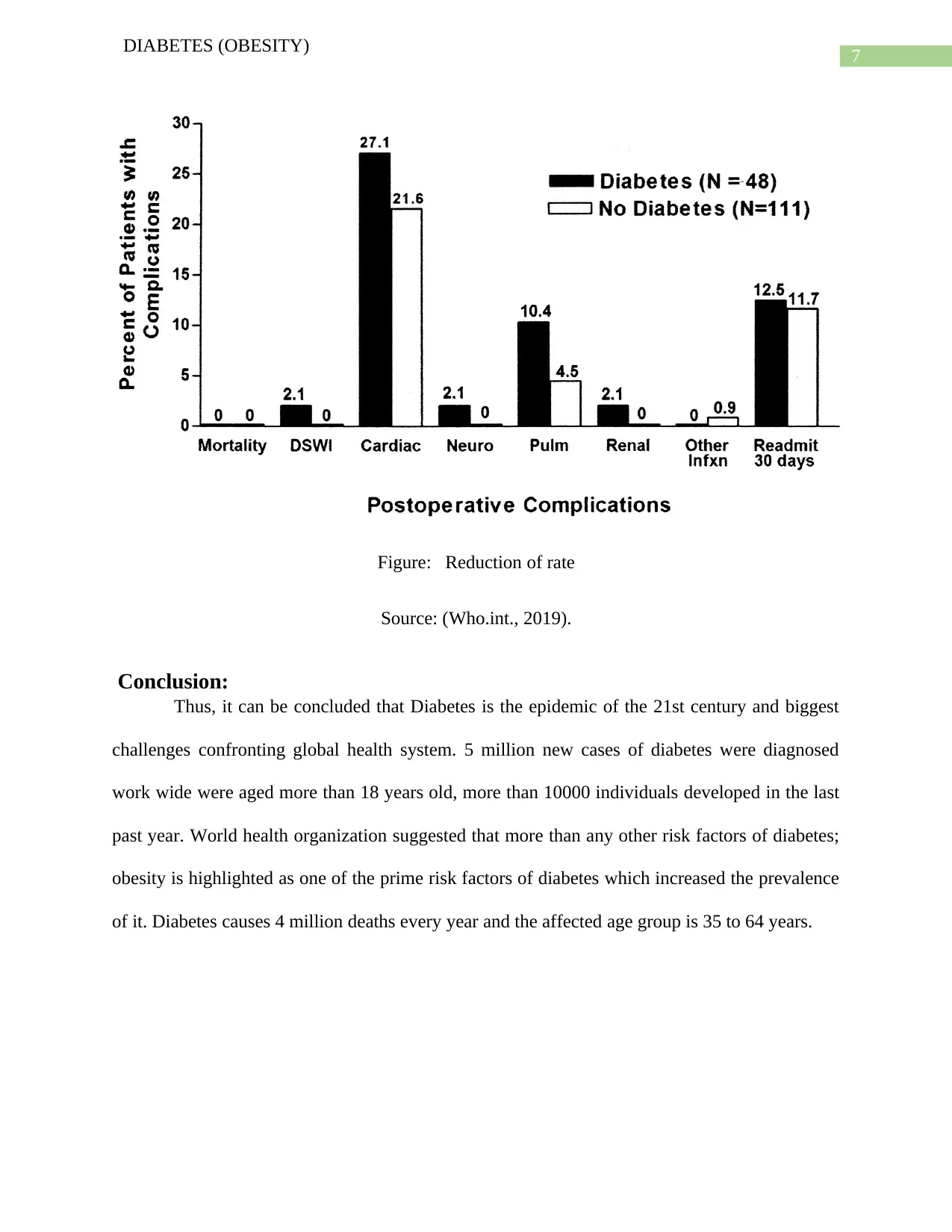
7
DIABETES (OBESITY)
Figure: Reduction of rate
Source: (Who.int., 2019).
Conclusion:
Thus, it can be concluded that Diabetes is the epidemic of the 21st century and biggest
challenges confronting global health system. 5 million new cases of diabetes were diagnosed
work wide were aged more than 18 years old, more than 10000 individuals developed in the last
past year. World health organization suggested that more than any other risk factors of diabetes;
obesity is highlighted as one of the prime risk factors of diabetes which increased the prevalence
of it. Diabetes causes 4 million deaths every year and the affected age group is 35 to 64 years.
DIABETES (OBESITY)
Figure: Reduction of rate
Source: (Who.int., 2019).
Conclusion:
Thus, it can be concluded that Diabetes is the epidemic of the 21st century and biggest
challenges confronting global health system. 5 million new cases of diabetes were diagnosed
work wide were aged more than 18 years old, more than 10000 individuals developed in the last
past year. World health organization suggested that more than any other risk factors of diabetes;
obesity is highlighted as one of the prime risk factors of diabetes which increased the prevalence
of it. Diabetes causes 4 million deaths every year and the affected age group is 35 to 64 years.
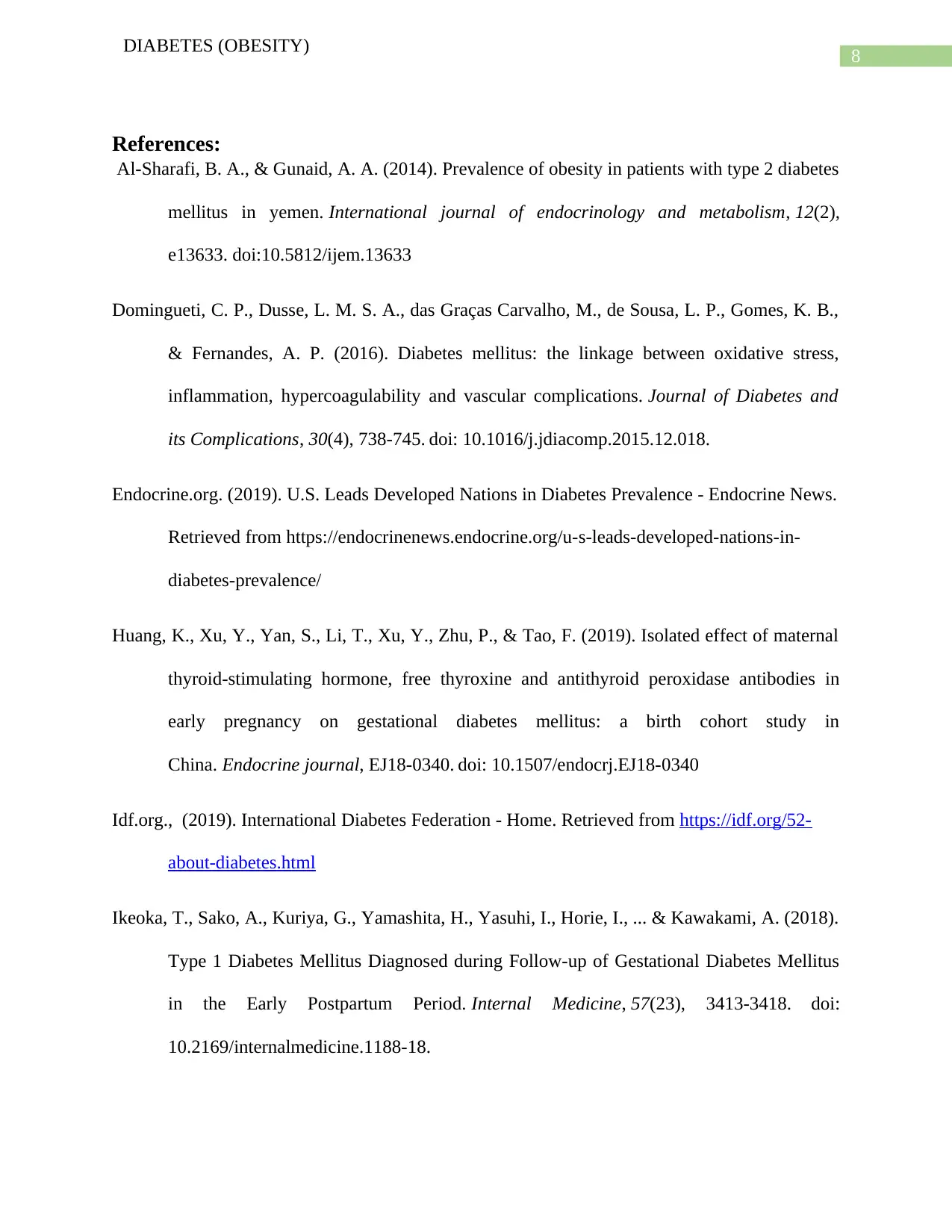
8
DIABETES (OBESITY)
References:
Al-Sharafi, B. A., & Gunaid, A. A. (2014). Prevalence of obesity in patients with type 2 diabetes
mellitus in yemen. International journal of endocrinology and metabolism, 12(2),
e13633. doi:10.5812/ijem.13633
Domingueti, C. P., Dusse, L. M. S. A., das Graças Carvalho, M., de Sousa, L. P., Gomes, K. B.,
& Fernandes, A. P. (2016). Diabetes mellitus: the linkage between oxidative stress,
inflammation, hypercoagulability and vascular complications. Journal of Diabetes and
its Complications, 30(4), 738-745. doi: 10.1016/j.jdiacomp.2015.12.018.
Endocrine.org. (2019). U.S. Leads Developed Nations in Diabetes Prevalence - Endocrine News.
Retrieved from https://endocrinenews.endocrine.org/u-s-leads-developed-nations-in-
diabetes-prevalence/
Huang, K., Xu, Y., Yan, S., Li, T., Xu, Y., Zhu, P., & Tao, F. (2019). Isolated effect of maternal
thyroid-stimulating hormone, free thyroxine and antithyroid peroxidase antibodies in
early pregnancy on gestational diabetes mellitus: a birth cohort study in
China. Endocrine journal, EJ18-0340. doi: 10.1507/endocrj.EJ18-0340
Idf.org., (2019). International Diabetes Federation - Home. Retrieved from https://idf.org/52-
about-diabetes.html
Ikeoka, T., Sako, A., Kuriya, G., Yamashita, H., Yasuhi, I., Horie, I., ... & Kawakami, A. (2018).
Type 1 Diabetes Mellitus Diagnosed during Follow-up of Gestational Diabetes Mellitus
in the Early Postpartum Period. Internal Medicine, 57(23), 3413-3418. doi:
10.2169/internalmedicine.1188-18.
DIABETES (OBESITY)
References:
Al-Sharafi, B. A., & Gunaid, A. A. (2014). Prevalence of obesity in patients with type 2 diabetes
mellitus in yemen. International journal of endocrinology and metabolism, 12(2),
e13633. doi:10.5812/ijem.13633
Domingueti, C. P., Dusse, L. M. S. A., das Graças Carvalho, M., de Sousa, L. P., Gomes, K. B.,
& Fernandes, A. P. (2016). Diabetes mellitus: the linkage between oxidative stress,
inflammation, hypercoagulability and vascular complications. Journal of Diabetes and
its Complications, 30(4), 738-745. doi: 10.1016/j.jdiacomp.2015.12.018.
Endocrine.org. (2019). U.S. Leads Developed Nations in Diabetes Prevalence - Endocrine News.
Retrieved from https://endocrinenews.endocrine.org/u-s-leads-developed-nations-in-
diabetes-prevalence/
Huang, K., Xu, Y., Yan, S., Li, T., Xu, Y., Zhu, P., & Tao, F. (2019). Isolated effect of maternal
thyroid-stimulating hormone, free thyroxine and antithyroid peroxidase antibodies in
early pregnancy on gestational diabetes mellitus: a birth cohort study in
China. Endocrine journal, EJ18-0340. doi: 10.1507/endocrj.EJ18-0340
Idf.org., (2019). International Diabetes Federation - Home. Retrieved from https://idf.org/52-
about-diabetes.html
Ikeoka, T., Sako, A., Kuriya, G., Yamashita, H., Yasuhi, I., Horie, I., ... & Kawakami, A. (2018).
Type 1 Diabetes Mellitus Diagnosed during Follow-up of Gestational Diabetes Mellitus
in the Early Postpartum Period. Internal Medicine, 57(23), 3413-3418. doi:
10.2169/internalmedicine.1188-18.
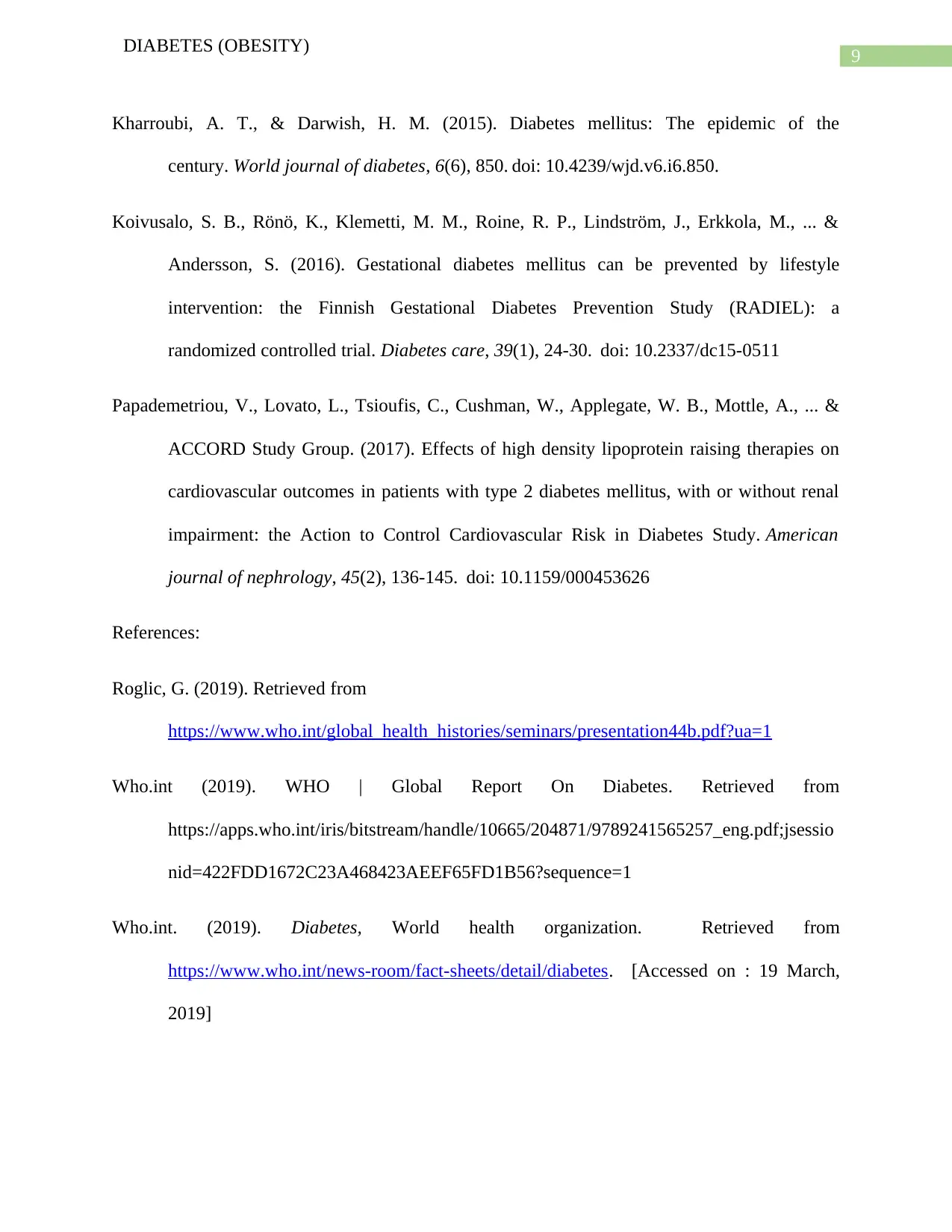
9
DIABETES (OBESITY)
Kharroubi, A. T., & Darwish, H. M. (2015). Diabetes mellitus: The epidemic of the
century. World journal of diabetes, 6(6), 850. doi: 10.4239/wjd.v6.i6.850.
Koivusalo, S. B., Rönö, K., Klemetti, M. M., Roine, R. P., Lindström, J., Erkkola, M., ... &
Andersson, S. (2016). Gestational diabetes mellitus can be prevented by lifestyle
intervention: the Finnish Gestational Diabetes Prevention Study (RADIEL): a
randomized controlled trial. Diabetes care, 39(1), 24-30. doi: 10.2337/dc15-0511
Papademetriou, V., Lovato, L., Tsioufis, C., Cushman, W., Applegate, W. B., Mottle, A., ... &
ACCORD Study Group. (2017). Effects of high density lipoprotein raising therapies on
cardiovascular outcomes in patients with type 2 diabetes mellitus, with or without renal
impairment: the Action to Control Cardiovascular Risk in Diabetes Study. American
journal of nephrology, 45(2), 136-145. doi: 10.1159/000453626
References:
Roglic, G. (2019). Retrieved from
https://www.who.int/global_health_histories/seminars/presentation44b.pdf?ua=1
Who.int (2019). WHO | Global Report On Diabetes. Retrieved from
https://apps.who.int/iris/bitstream/handle/10665/204871/9789241565257_eng.pdf;jsessio
nid=422FDD1672C23A468423AEEF65FD1B56?sequence=1
Who.int. (2019). Diabetes, World health organization. Retrieved from
https://www.who.int/news-room/fact-sheets/detail/diabetes. [Accessed on : 19 March,
2019]
DIABETES (OBESITY)
Kharroubi, A. T., & Darwish, H. M. (2015). Diabetes mellitus: The epidemic of the
century. World journal of diabetes, 6(6), 850. doi: 10.4239/wjd.v6.i6.850.
Koivusalo, S. B., Rönö, K., Klemetti, M. M., Roine, R. P., Lindström, J., Erkkola, M., ... &
Andersson, S. (2016). Gestational diabetes mellitus can be prevented by lifestyle
intervention: the Finnish Gestational Diabetes Prevention Study (RADIEL): a
randomized controlled trial. Diabetes care, 39(1), 24-30. doi: 10.2337/dc15-0511
Papademetriou, V., Lovato, L., Tsioufis, C., Cushman, W., Applegate, W. B., Mottle, A., ... &
ACCORD Study Group. (2017). Effects of high density lipoprotein raising therapies on
cardiovascular outcomes in patients with type 2 diabetes mellitus, with or without renal
impairment: the Action to Control Cardiovascular Risk in Diabetes Study. American
journal of nephrology, 45(2), 136-145. doi: 10.1159/000453626
References:
Roglic, G. (2019). Retrieved from
https://www.who.int/global_health_histories/seminars/presentation44b.pdf?ua=1
Who.int (2019). WHO | Global Report On Diabetes. Retrieved from
https://apps.who.int/iris/bitstream/handle/10665/204871/9789241565257_eng.pdf;jsessio
nid=422FDD1672C23A468423AEEF65FD1B56?sequence=1
Who.int. (2019). Diabetes, World health organization. Retrieved from
https://www.who.int/news-room/fact-sheets/detail/diabetes. [Accessed on : 19 March,
2019]
Secure Best Marks with AI Grader
Need help grading? Try our AI Grader for instant feedback on your assignments.
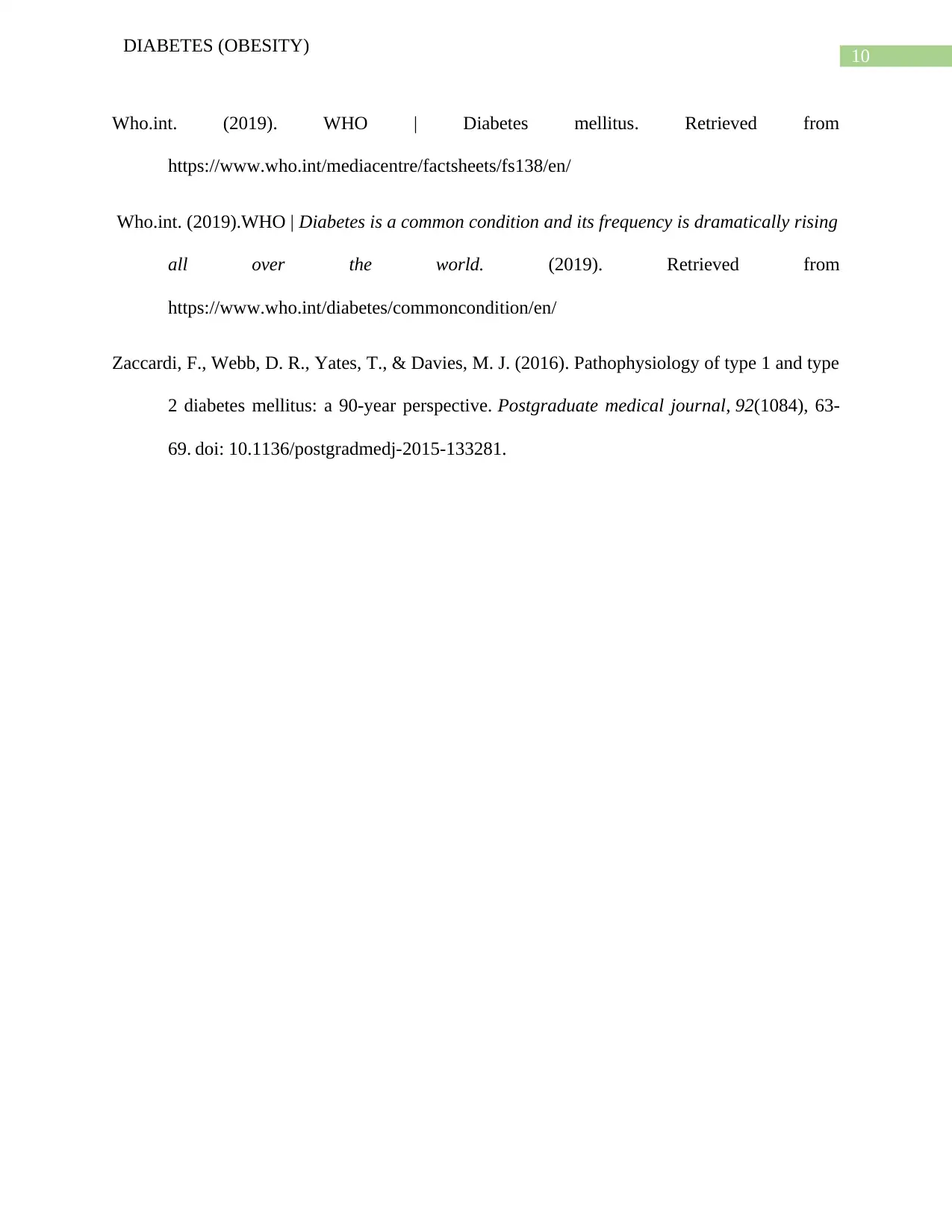
10
DIABETES (OBESITY)
Who.int. (2019). WHO | Diabetes mellitus. Retrieved from
https://www.who.int/mediacentre/factsheets/fs138/en/
Who.int. (2019).WHO | Diabetes is a common condition and its frequency is dramatically rising
all over the world. (2019). Retrieved from
https://www.who.int/diabetes/commoncondition/en/
Zaccardi, F., Webb, D. R., Yates, T., & Davies, M. J. (2016). Pathophysiology of type 1 and type
2 diabetes mellitus: a 90-year perspective. Postgraduate medical journal, 92(1084), 63-
69. doi: 10.1136/postgradmedj-2015-133281.
DIABETES (OBESITY)
Who.int. (2019). WHO | Diabetes mellitus. Retrieved from
https://www.who.int/mediacentre/factsheets/fs138/en/
Who.int. (2019).WHO | Diabetes is a common condition and its frequency is dramatically rising
all over the world. (2019). Retrieved from
https://www.who.int/diabetes/commoncondition/en/
Zaccardi, F., Webb, D. R., Yates, T., & Davies, M. J. (2016). Pathophysiology of type 1 and type
2 diabetes mellitus: a 90-year perspective. Postgraduate medical journal, 92(1084), 63-
69. doi: 10.1136/postgradmedj-2015-133281.
1 out of 11
Related Documents
Your All-in-One AI-Powered Toolkit for Academic Success.
+13062052269
info@desklib.com
Available 24*7 on WhatsApp / Email
![[object Object]](/_next/static/media/star-bottom.7253800d.svg)
Unlock your academic potential
© 2024 | Zucol Services PVT LTD | All rights reserved.





